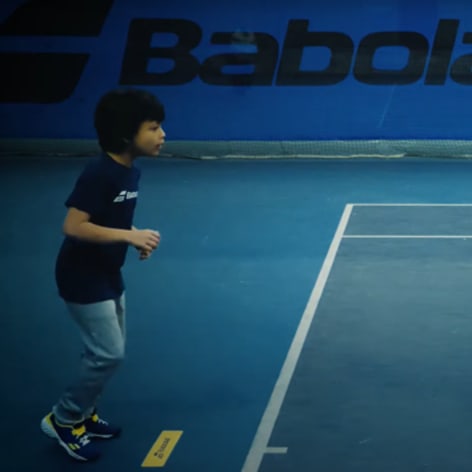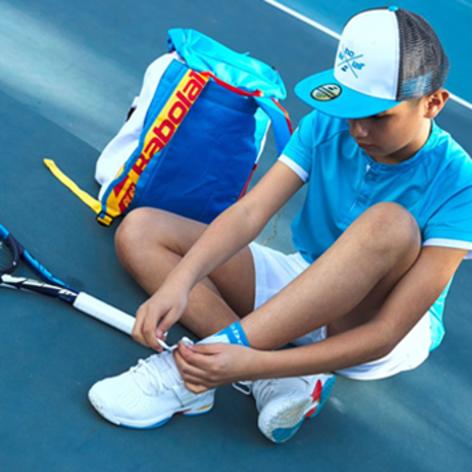Choosing the right racquet for your child is essential: to help them progress smoothly, they need a racquet adapted to their abilities.
Choosing the right size tennis racquet
The ideal size of a tennis racquet depends on two main criteria: your child's height and their level of play.
Based on your junior/child's height
Choosing the right size tennis racquet is very important and should be based on the child's height. A properly sized racquet will facilitate learning to hit the ball correctly and protect your child's arm. A racquet that is too large and potentially too heavy will tire them out more quickly.
To determine the correct racquet size, follow this three-step test:
1. Stand upright wearing tennis shoes.
2. Hold the racquet by the handle with your arm extended towards the ground.
3. If the racquet is less than 5 cm from the ground, it is the correct size. Otherwise, it is recommended to choose a different size.
Note: If your child is between two racquet sizes, choose the smaller one.
Based on their level of play
Your child’s level of play will also influence the type of racquet to choose.
If your child is a beginner:
For young children, aluminum racquets such as the Nadal Junior, B’Fly, and Ballfighter are the lightest, with a larger head size to make hitting the first balls easier and learning more enjoyable and fun.
For beginners over 1.5 m tall, the Boost Aero or Boost Drive racquets are excellent choices for learning.
If Your child is at an intermediate level:
For children who are starting to play regularly and improving their technique, opt for Aero Junior and Drive Junior racquets. Their graphite composite frames enhance performance while remaining very easy to handle.
For intermediate junior players transitioning to adult racquets, we recommend 100% graphite racquets like the Babolat Evo Aero Lite and Evo Drive Lite, designed for those refining their skills.
If your child is at an advanced level:
100% graphite racquets are adaptations of those used by professional players like Rafael Nadal or Dominic Thiem, designed for young champions’ morphologies. They help young players gain the power and precision needed to perform at a high level.
For smaller players (under 1.5 m), prioritize models such as Pure Aero Jr, Pure Drive Jr, and Pure Strike Jr.
For young teens transitioning to adult models, lighter racquets like the Pure Aero Lite, Pure Drive Lite, Pure Drive Super Lite, and Pure Strike Lite are ideal for their first steps into competition.

Choosing a racquet based on hand size
The tennis grip size is crucial for ensuring a proper hold on the racquet, a fundamental aspect of learning tennis.
To determine the right grip size:
1. Measure the distance between the second line of the palm (opposite the middle finger) and the tip of the middle finger—this is called the hand span.
2. Cut a string to match this length and wrap it around the racquet handle. If the two ends of the string meet, it's the right grip size for your child.
To facilitate learning and enable rapid progress, Babolat has integrated educational markers into racquets for young children, endorsed by Toni Nadal, Director of the Rafa Nadal Academy by Movistar and Rafael Nadal's former coach:
- The Memo Grip (on BALLFIGHTER 17-19-21 & B'FLY 19-21 racquets) highlights the correct gripping area.
- The Improver Grip (on BALLFIGHTER 23-25 & B'FLY 23-25 racquets) helps children learn the appropriate grip for each shot.
- On all BALLFIGHTER & B'FLY racquets: two eyes are drawn on the racquet frame to teach children the ready position.

Choosing the strings for junior/kids tennis racquets
Our different string types
The tennis strings are the engine of the racquet! It’s an important parameter for young players starting to play regularly at a good level: it enhances the frame's performance and, if poorly chosen, can cause arm pain, poor sensations, and unnecessary point losses.
To find the ideal strings, consider the following:
String Type: Multifilament or Monofilament
1. Our Multifilament range, including Xalt, Xcel, and AddiXon +, is ideal for junior players. These strings are soft and arm-friendly, allowing for easy, powerful strokes while preserving muscles and joints.
2. Monofilament strings are much stiffer and suited for players with advanced technical skills. Often used by professionals, Monofilament strings (e.g., RPM Blast, RPM Power) are not suitable for players under 12, except for the RPM Soft: firmer and more durable than a multifilament, it’s an excellent option for young competitors who want to explore spin while maintaining some hitting comfort.
For optimal performance, we recommend restringing the racquet approximately every 20 hours of play.
String tension
The higher the string tension, the stiffer the strings, providing more control. Conversely, lower tension delivers more power.
The string gauge (diameter expressed in millimeters) also influences power and hitting comfort.
Consult a stringer or your tennis coach to find the most suitable strings for your child's age and playing level.
How to care of your junior/kids tennis racquet ?
Here are some tips to care for the tennis racquet:
- Do not leave it in the sun or very hot places, as this can damage the frame and strings.
- Tennis racquets are fragile; avoid hitting them on the ground.
- For transportation, use a suitable tennis bag to protect the equipment from shocks and temperature changes. Its compartments can also carry other tennis essentials, like shoes.






